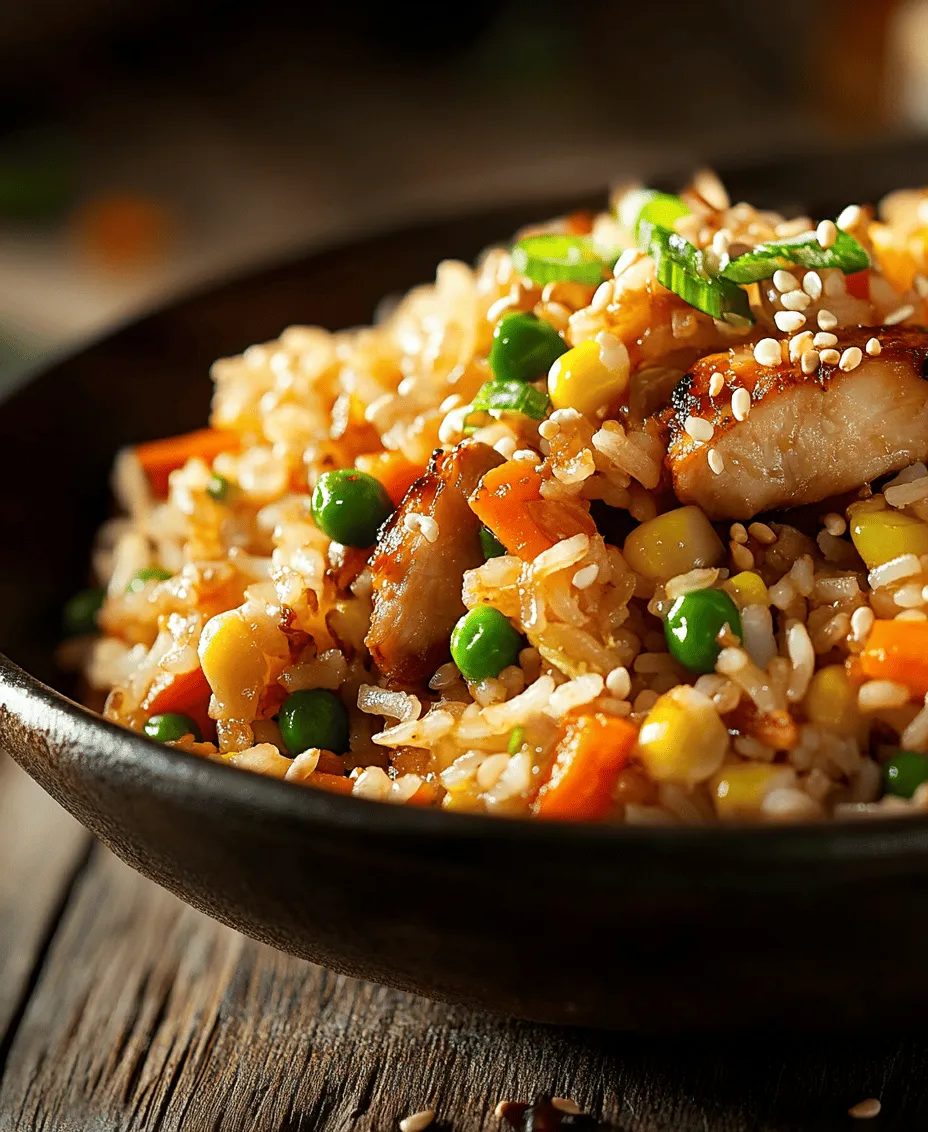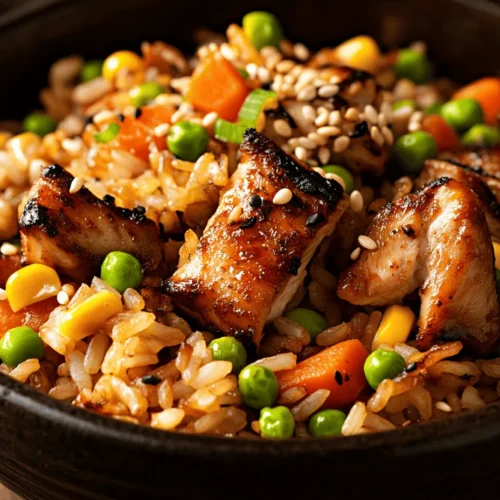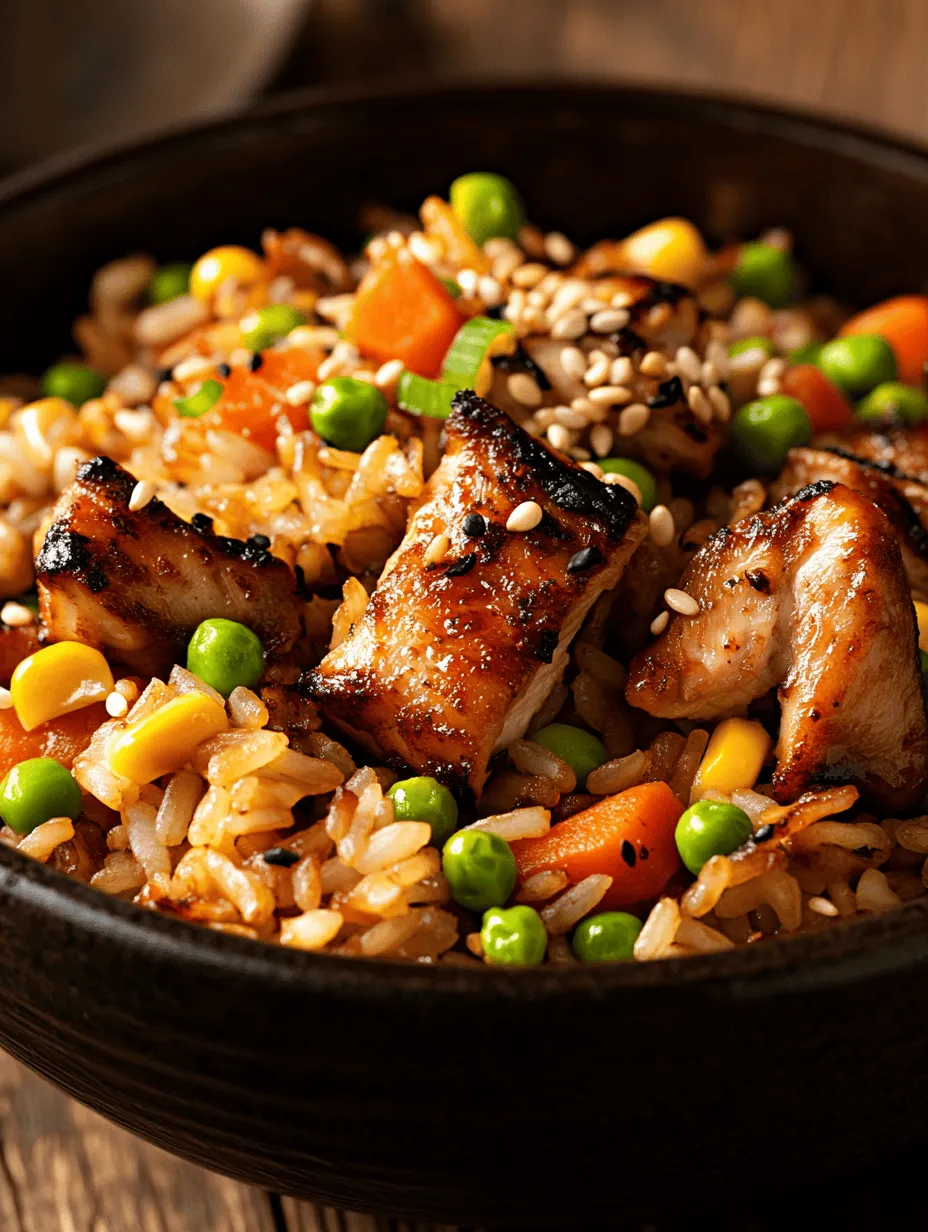Introduction
The art of cooking is a journey that invites us to explore flavors, techniques, and cultural traditions. One dish that beautifully encapsulates this adventure is Savory Japanese BBQ Chicken Fried Rice. This recipe is not just a meal; it’s an experience that brings together the rich umami flavors of Japanese cuisine with the comforting familiarity of fried rice. In an age where fusion cooking reigns supreme, this dish stands out as a testament to the harmonious blend of culinary influences. It combines the smoky, sweet taste of grilled chicken marinated in traditional Japanese seasonings with the satisfying texture of perfectly cooked rice.
Fried rice is a beloved staple in many Asian cuisines, but when infused with Japanese BBQ flavors, it transcends the ordinary. The marriage of tender chicken, fragrant rice, and a medley of colorful vegetables creates not only a feast for the palate but also for the eyes. Furthermore, this dish is versatile; it can be served as a standalone meal or as a side dish at gatherings, making it a perfect addition to any dinner table.
In this article, we will delve into the intricacies of creating this delightful dish, from understanding the key ingredients to exploring variations and serving suggestions. Whether you’re a seasoned chef or a culinary novice, this guide will equip you with the knowledge and skills needed to prepare a mouthwatering fried rice extravaganza.
Understanding the Key Ingredients
Exploring the Role of Jasmine Rice
At the heart of every great fried rice dish is the rice itself, and for our Savory Japanese BBQ Chicken Fried Rice, we recommend using jasmine rice. Known for its subtle floral aroma and slightly sticky texture, jasmine rice enhances the overall experience of the dish. One of the most crucial aspects of using jasmine rice is the importance of using day-old rice for optimal texture. Freshly cooked rice tends to be too moist, leading to clumping and a mushy consistency when stir-fried.
Day-old rice, on the other hand, has had time to cool and dry out, making it less sticky and ideal for frying. The starch content in jasmine rice plays a significant role in the dish’s overall quality, allowing each grain to separate beautifully when tossed with other ingredients. For best results, store your freshly cooked rice in the refrigerator overnight, allowing it to firm up and develop the perfect texture for frying.
Highlighting the Chicken’s Marination Process
To elevate the flavors of our fried rice, marinating the chicken is an essential step. This process ensures that the chicken is infused with the rich flavors of the marinade, making each bite a burst of taste. The marinade typically consists of a combination of soy sauce, mirin (a sweet rice wine), sake, and a touch of sesame oil. Each of these ingredients contributes to the overall flavor profile of the dish:
– Soy Sauce: This staple in Japanese cuisine provides a salty, umami-rich base that enhances the chicken’s natural flavor.
– Mirin: Its sweetness balances the saltiness of the soy sauce, adding depth to the marinade.
– Sake: This traditional Japanese alcoholic beverage adds a unique flavor and helps tenderize the chicken.
– Sesame Oil: A drizzle of this fragrant oil imparts a nutty aroma, elevating the dish’s sensory appeal.
When marinating the chicken, aim to let it soak for at least 30 minutes, though longer is better for maximum flavor infusion. Place the chicken in a resealable plastic bag or bowl, pour in the marinade, and ensure the pieces are well-coated. After marination, allow the chicken to rest at room temperature for about 10-15 minutes before cooking, which helps ensure even cooking.
The Essential Aromatics: Garlic and Green Onions
No fried rice is complete without the aromatic touch of garlic and green onions. Garlic serves as a crucial flavor enhancer, adding complexity and a savory depth to the dish. When sautéed, garlic releases its natural oils, creating a fragrant base that permeates the entire dish. However, it’s essential to pay attention to the timing. Garlic can burn quickly, turning bitter and unpleasant, so it should be added to the pan at just the right moment—typically just before the vegetables.
Green onions, or scallions, add a refreshing crunch and a mild onion flavor that balances the richness of the chicken and the oils used in cooking. They can be used both in the cooking process and as a garnish, providing a bright pop of color. When preparing your fried rice, chop the green onions finely, reserving some of the green tops for garnishing at the end.
Diving into the Flavor Enhancers: Sauces and Oils
The flavor profile of Savory Japanese BBQ Chicken Fried Rice is further enriched with a variety of sauces and oils. Understanding these elements and how they contribute to the dish’s aroma and taste is key to mastering this recipe.
– Soy Sauce: This ubiquitous ingredient provides the salty backbone of the dish, contributing to the Maillard reaction that gives fried rice its characteristic golden color.
– Oyster Sauce: This thick, savory sauce adds a hint of sweetness and a rich umami flavor, making it a perfect complement to the soy sauce.
– Teriyaki Sauce: For a touch of sweetness, teriyaki sauce can be drizzled over the chicken during the cooking process, enhancing its glaze and flavor.
– Sesame Oil: A finishing touch of sesame oil just before serving infuses the dish with a warm, nutty aroma that tantalizes the senses.
Exploring the Mixed Vegetables
To round out our dish, incorporating a mix of vegetables not only enhances the nutritional value but also adds a vibrant variety of colors and textures. Common choices for Japanese fried rice include peas, carrots, and corn. Each of these vegetables contributes its unique flavor while providing a satisfying crunch.
– Peas: Rich in vitamins and minerals, peas add a sweet pop of flavor and a lovely green color to the dish.
– Carrots: Diced carrots lend a slight sweetness and a bright orange hue, making the dish visually appealing.
– Corn: Sweet corn kernels provide a burst of sweetness and a nice contrast to the savory elements of the dish.
When selecting vegetables, you can opt for fresh or frozen varieties based on convenience. Frozen vegetables are often picked at peak ripeness and flash-frozen, retaining their nutrients and flavor. If using fresh vegetables, ensure they are crisp and vibrant, as this will contribute to the overall freshness of your fried rice.
Step-by-Step Preparation of Savory Japanese BBQ Chicken Fried Rice
Marinating the Chicken
To begin our culinary journey, the first step involves marinating the chicken. Start by selecting boneless, skinless chicken thighs or breasts for their tenderness and flavor. Cut the chicken into bite-sized pieces to ensure even cooking and better flavor absorption. In a mixing bowl, combine the soy sauce, mirin, sake, and sesame oil to create your marinade.
Add the chicken pieces to the bowl, ensuring they are fully submerged in the marinade. For maximum flavor, cover the bowl with plastic wrap or transfer the mixture to a resealable plastic bag, pressing out as much air as possible. Allow the chicken to marinate in the refrigerator for at least 30 minutes; however, for the best flavor, aim for a couple of hours or even overnight if time permits.
Preparing the Rice
Next, it’s time to prepare the rice. As mentioned earlier, day-old jasmine rice is ideal for this recipe. If you don’t have leftover rice, you can cook fresh jasmine rice, spread it out on a baking sheet, and refrigerate it for at least an hour to cool down. This helps reduce moisture and prevents clumping.
When cooking your rice, follow a ratio of 1 cup of rice to 1.5 cups of water, adding a pinch of salt for flavor. Rinse the rice under cold water until the water runs clear to remove excess starch, which can make the rice sticky. Once cooked, fluff the rice with a fork and allow it to cool completely before using it in your fried rice.
Cooking the Chicken to Perfection
With the chicken marinated and the rice prepared, it’s time to cook the chicken. Heat a large skillet or wok over medium-high heat and add a tablespoon of vegetable oil. Once the oil is shimmering, remove the chicken from the marinade, allowing any excess liquid to drip off. Carefully place the chicken pieces in the hot skillet in a single layer, ensuring they don’t overcrowd the pan.
Cook the chicken for about 5-7 minutes, turning occasionally to achieve a golden brown color on all sides. The cooking time may vary depending on the thickness of the chicken pieces. Use a meat thermometer to ensure the chicken reaches an internal temperature of 165°F (75°C) for safety. Once cooked, transfer the chicken to a plate and set it aside to rest.
Sautéing the Aromatics
With the chicken cooked, it’s time to sauté the aromatics. In the same skillet, add another splash of oil if needed, and reduce the heat to medium. Add minced garlic to the hot oil and sauté for about 30 seconds, stirring continuously to prevent burning. The garlic should become fragrant and lightly golden, but not browned.
Once the garlic is aromatic, add the chopped green onions (reserving some for garnish) and your choice of mixed vegetables. Sauté the mixture for 2-3 minutes until the vegetables are tender but still vibrant. This step is crucial, as it allows the flavors to meld and infuse the oil with aromatic goodness.
Once the vegetables are cooked to your liking, it’s time to bring the dish together by adding the rice and cooked chicken, which we will explore in the next section.
This foundational preparation sets the stage for a delightful culinary experience, ensuring that every element of the Savory Japanese BBQ Chicken Fried Rice is infused with flavor and texture. Stay tuned as we continue this mouthwatering journey in the second part of our article, where we will combine all the ingredients into a cohesive and delicious dish.

Incorporating Eggs into the Dish
Eggs are a staple in many fried rice recipes and add a rich, creamy texture that elevates the overall dish. When scrambling eggs within a stir-fry context, it’s important to follow specific techniques to ensure they are integrated smoothly without becoming overcooked and rubbery.
Techniques for Scrambling Eggs Effectively
Start by cracking the eggs into a bowl and whisking them until the yolks and whites are fully combined. This step is crucial as it helps create a uniform texture when cooked. Preheat your skillet over medium-high heat and add a splash of oil. Once the oil shimmers, reduce the heat slightly to medium and pour in the whisked eggs.
To scramble the eggs effectively, use a spatula to gently push the eggs from the edges of the pan towards the center. This technique allows the uncooked parts to flow to the edges, ensuring even cooking. Remember, the goal is soft, slightly runny curds that will continue to cook slightly after being removed from the heat. Once they begin to set, remove them from the skillet and set aside. This prevents the eggs from overcooking when you combine them with the rice later.
How to Integrate Eggs Without Overcooking
To successfully integrate the scrambled eggs back into the fried rice without overcooking them, wait until the rice is nearly done cooking. Once your rice is fluffy and well-fried, push the rice to one side of the pan, creating a space for the eggs. Gently fold the scrambled eggs into the rice, ensuring a light touch to maintain their softness. This method allows the eggs to blend with the rice without losing their delicate texture.
Frying the Rice: Techniques and Tips
Achieving perfectly fried rice is an art that requires attention to detail. Follow these step-by-step instructions to create fluffy, flavorful rice that serves as the perfect base for your savory Japanese BBQ chicken.
Step-by-Step Instructions for Achieving Fluffy Fried Rice
1. Use Day-Old Rice: For optimal results, always use day-old, cold rice. Freshly cooked rice tends to be too moist and sticky, leading to clumpy fried rice. If you don’t have leftover rice, spread freshly cooked rice on a baking sheet and refrigerate it for about 30 minutes to cool and dry out.
2. Heat the Oil: In a large, non-stick skillet or wok, heat a tablespoon of oil over medium-high heat. You want the oil to shimmer but not smoke.
3. Add Aromatics: Start by sautéing minced garlic and ginger until fragrant, about 30 seconds. This step infuses the oil with aromatic flavors that will enhance your fried rice.
4. Add Vegetables: Toss in any vegetables you desire, such as diced carrots, peas, or bell peppers. Stir-fry for 2-3 minutes until they are tender-crisp.
5. Incorporate the Rice: Add the cold, day-old rice to the skillet. Use a spatula to break up any clumps gently. Spread the rice evenly across the pan and allow it to sit undisturbed for 1-2 minutes. This technique helps the rice to fry rather than steam.
6. Stir-Fry: After letting the rice sit, start stirring it gently. Keep the rice moving to ensure even cooking and prevent it from sticking to the pan. Repeat this process for about 5-7 minutes until the rice is heated through and has a slight crisp.
7. Season the Rice: Drizzle soy sauce, sesame oil, and any additional seasonings over the rice. Stir well to combine, ensuring that every grain is coated with flavor.
Common Mistakes to Avoid When Frying Rice
– Using Fresh Rice: As mentioned, never use freshly cooked rice, as it will lead to mushy fried rice.
– Overcrowding the Pan: If you’re making a large batch, consider cooking in batches. Overcrowding the pan leads to steaming rather than frying.
– Neglecting to Let Rice Sit: Allowing the rice to sit undisturbed for a minute or two helps achieve that perfect texture.
Combining All Ingredients
With the scrambled eggs and fluffy rice prepared, it’s time to bring everything together. The final steps are crucial in ensuring your fried rice is a harmonious blend of flavors.
The Final Steps to Bring the Dish Together
1. Add Chicken: If you haven’t already, add your marinated and cooked Japanese BBQ chicken to the skillet. Cut it into bite-sized pieces for even distribution.
2. Fold in the Eggs: As mentioned earlier, push the rice to one side and fold in the scrambled eggs. This method allows the eggs to maintain their texture while thoroughly combining with the rice and chicken.
3. Check for Seasoning: Taste the fried rice and adjust the flavor as necessary. You might want to add more soy sauce, a dash of salt, or even a sprinkle of white pepper for added depth.
4. Toss to Combine: Use a spatula to gently toss all the ingredients together, ensuring even distribution throughout. This step is vital in allowing the flavors to meld beautifully.
5. Heat Through: Allow the mixture to cook for an additional minute to ensure everything is heated through.
Garnishing and Serving Suggestions
The presentation of your dish plays a significant role in the overall dining experience. A well-garnished plate not only looks appealing but also enhances the flavor profile of your dish.
The Importance of Presentation
Garnishing enhances your fried rice visually and adds layers of flavor and texture. A well-presented dish makes it more enticing and enjoyable for your guests.
Recommendations for Serving Dishes that Complement the Dish’s Aesthetic
Opt for a wide, shallow bowl or plate to serve your fried rice. This style allows the vibrant colors of the vegetables and chicken to stand out. A plate with a contrasting color can enhance the visual appeal even further.
Creative Garnishing Ideas
– Toasted Sesame Seeds: Sprinkle toasted sesame seeds over the top for a nutty flavor and added crunch. They pair beautifully with the flavors of the chicken and rice.
– Nori Strips: Add thin strips of nori (seaweed) for an umami kick and visual appeal. The seaweed adds a delightful contrast to the ingredients while enhancing the Japanese theme of the dish.
Pairing Suggestions
To elevate your dining experience, consider pairing your savory Japanese BBQ chicken fried rice with complementary side dishes and beverages.
Complementary Side Dishes and Beverages That Elevate the Dining Experience
– Miso Soup: A warm bowl of miso soup is a traditional accompaniment that complements the flavors of your fried rice.
– Japanese Pickles (Tsukemono): These tangy pickles provide a refreshing contrast to the richness of the fried rice.
– Green Tea: Serve with a hot cup of green tea, which enhances the meal’s flavors and aids digestion.
Exploring Traditional Japanese Accompaniments to Serve Alongside
For a more authentic experience, consider serving your fried rice alongside dishes like edamame or a fresh cucumber salad dressed with rice vinegar.
Exploring Variations of the Recipe
The versatility of fried rice allows for various adaptations to cater to different dietary needs and preferences.
Vegetarian and Vegan Adaptations
To modify this recipe for plant-based diets, simply replace the chicken with a protein-rich alternative like tofu or tempeh. Use soy sauce or tamari to ensure the dish remains delicious without compromising flavor integrity.
Suggested Substitutes That Maintain Flavor Integrity
– Tofu: Marinate and sauté tofu cubes in the same BBQ sauce for a flavorful alternative.
– Vegetables: Load up on a variety of vegetables such as broccoli, bell peppers, and snap peas for added nutrition and color.
Regional Variations on Fried Rice
Fried rice is a dish found in various cuisines, each adding unique ingredients and flavors. Consider exploring these adaptations:
– Chinese Yangzhou Fried Rice: Typically includes char siu (Chinese BBQ pork), shrimp, and a mix of vegetables.
– Thai Basil Fried Rice: Features fresh basil, chilies, and a hint of lime for a zesty kick.
Customizing for Dietary Needs
For those with dietary restrictions, customizing your fried rice is straightforward:
– Gluten-Free: Use tamari instead of soy sauce, ensuring all ingredients are gluten-free.
– Low-Carb: Substitute rice with cauliflower rice for a low-carb version that still satisfies.
Tips for Ensuring Flavor and Texture Remain Intact in Adaptations
Regardless of the adaptations, always season your ingredients well and cook them separately before combining, as this ensures each component retains its individual flavor.
Conclusion
Savory Japanese BBQ Chicken Fried Rice is more than just a recipe; it is a canvas for creativity, flavor, and cultural appreciation. By understanding the ingredients and techniques involved, you can create a dish that not only satisfies hunger but also brings family and friends together around the table. This fried rice extravaganza invites you to explore the delightful blend of flavors and textures, making it a staple in your culinary repertoire. Enjoying this dish is about savoring each bite and celebrating the joy of cooking. Whether it’s a weeknight dinner or a special occasion, this recipe is sure to impress and satisfy.



